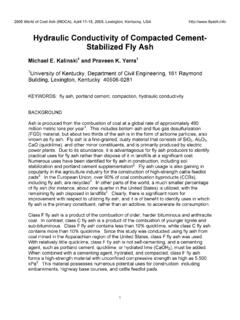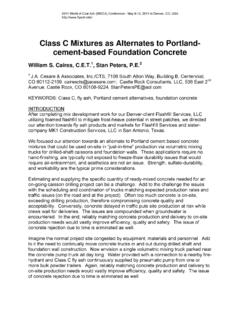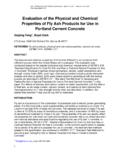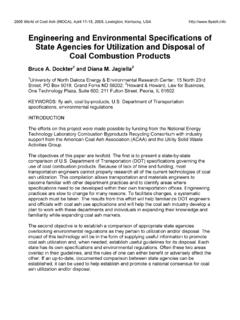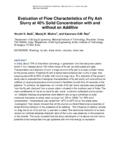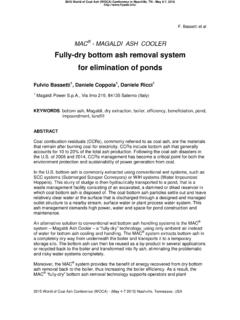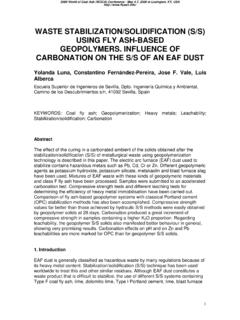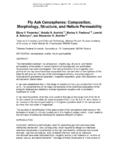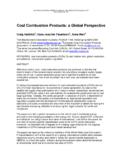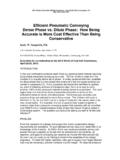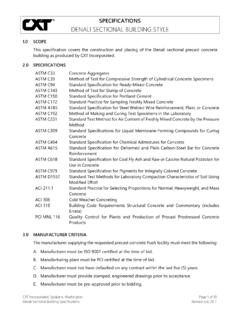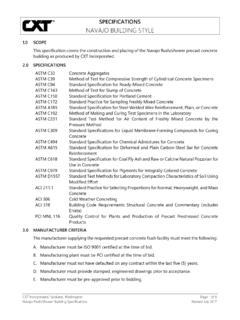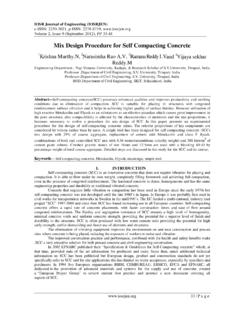Transcription of In Situ Stabilization/Solidification (ISS) in the Power ...
1 In Situ Stabilization/Solidification (ISS) in the Power Industry and Applications for Coal Combustion Products (CCP) Roy E. Wittenberg, PE1, Christopher A. Robb, PE1, and Glenn R. Luke, PE1 1 Natural Resource Technology, Inc., 23713 W. Paul Road, Suite D, Pewaukee, Wisconsin 53072 KEYWORDS: stabilization , solidification , leachability INTRODUCTION In situ Stabilization/Solidification (ISS) is a remediation technology that may offer an effective alternative for reducing leachability and improving geotechnical stability in coal combustion product (CCP) management applications. Over the last 10 years ISS has increasingly become a more economical remedy as design and construction expertise has developed, and costs are approaching the point where they are competitive with excavation and off-site disposal. ISS technology is an important and powerful tool for environmental remediation because it: Is highly effective on previously difficult to remediate sites Has continued to gain community and regulatory acceptance Has developed a history of documented effectiveness ISS applications completed to-date are relatively small in scale compared to most CCP management facilities.
2 However, ISS technology has advanced to the point where it is now a viable consideration from a cost perspective when remediation of CCP management sites is necessary. One remaining limiting factor is that there are few examples demonstrating the effectiveness of ISS in CCP applications. This paper helps fill that void by highlighting the current state of the practice, and providing results of bench and pilot scale applications using ISS on CCPs. OVERVIEW OF ISS What is ISS? solidification and stabilization are names applied to two technologies that are closely related in that both use chemical or physical processes to reduce potential adverse effects to the environment from contaminated soil, sediment, and sludge. solidification and stabilization are often used and occur together depending on the type, distribution, 2013 World of Coal Ash (WOCA) Conference - April 22-25, 2013 in Lexington, and concentration of contaminants.
3 These technologies usually do not destroy contaminants. Instead, they slow or prevent contaminants from migrating into the surrounding environment. Each of these technologies is defined below: solidification : This is primarily a physical process whereby the contaminated media (soil, sediment, or sludge) is converted into a solid, monolithic material that is more resistant to physical degradation and less susceptible to leaching than the untreated material. Constituents of concern (COC) are encapsulated and immobilized in the solidified matrix to reduce long-term mobility and toxicity. stabilization : stabilization is a chemical process whereby the soil s hazard potential is reduced by converting the constituents of concern into less soluble, mobile, or toxic forms. This process is applicable to constituents such as metals that have the ability to chemically bond or react with the stabilizing reagent to reduce long-term mobility or toxicity.
4 The ISS process is typically accomplished by mixing targeted soils with binders such as Portland cement and/or other pozzolan mixtures. Pozzolans are siliceous or aluminous materials which in and of themselves are not cementitious but when mixed with water and calcium hydroxide form compounds with cementitious properties ( , Class F fly ash). Some materials are both pozzolanic and cementitious such as ground granulated blast furnace slag (GGBFs), cement kiln dust, and Class C fly ash. (Ramme and Tharaniyil, 2004 [1]) Additives such as bentonite, organoclay, and plasticizers are sometimes blended with binders to further reduce hydraulic conductivity and leachability of targeted materials. For many applications the most commonly used reagents consist of GGBFS, Portland cement, and bentonite. An example of ISS treated material is provided below: Figure 1 Example of Solidified/Stabilized Material with Coal Tar Inclusion The material in Figure 1 has a concrete-like appearance with little resemblance to the original soil matrix prior to mixing with reagents.
5 On the left side of the sample, an inclusion of coal tar residuals is visible which is illustrative of the solidification process. Criteria typically used to assess ISS performance include: Leachability: The preferred laboratory method is American Nuclear Society (ANS) method to evaluate leaching of constituents from ISS material under laboratory conditions. Sample molds are cured a minimum of 28 days prior to leachability testing. The molds are then placed in a bath with demineralized water undisturbed to simulate full scale conditions where the monolith is surrounded with groundwater. During testing, samples of leachate are collected at set time intervals and submitted for laboratory analysis for a period of up to 90 days in accordance with method protocols. This test is different from other types of leaching tests such as the Synthetic Precipitation Leaching Procedure (SPLP) and the Toxicity Characteristic Leaching Procedure (TCLP) which require destructive sample preparation as part of the laboratory method, and are therefore not reflective of full scale conditions for a monolith.
6 Unconfined Compressive Strength (UCS): Strength is measured using American Society of Testing and Materials (ASTM) methods D2166 or D1633. A typical minimum specified design strength is 50 pounds per square inch (psi). Hydraulic Conductivity: Hydraulic conductivity is measured using ASTM method D5084. Typical design permeabilities are in the range of 1x10-6 to 1x10-8 centimeters per second (cm/s). Leachability is typically evaluated during the bench and pilot scale design phases. UCS and hydraulic conductivity are evaluated during the bench and pilot scale phases, and are the primary performance criteria typically measured during full scale construction. Leachability, UCS, and hydraulic conductivity results are correlated during the bench and pilot scale phases to provide a high level of confidence that measured values for UCS and hydraulic conductivity obtained during full scale construction will provide acceptable indicators for long term leachability.
7 Current State of the Practice The use of ISS as a primary remediation technology has gained significant support from the USEPA but is less consistent on a state by state level. Some states have been very aggressive whereas some states are still relatively young in their understanding of the process. Consequently, the familiarity and experience with the ISS technology varies considerably. Presently, 26 states have reported implementing ISS (ITRC, 2011 [2] ). In addition, the USEPA has documented that ISS is one of the most common in situ technologies used at CERCLA sites (USEPA, 2010 [3] ). ISS has demonstrated effectiveness for remediation of various organics contaminants (VOCs, SVOCs, PAHs, and PCBs) and inorganic contaminants (trace metal and radioactive materials). It has been used by a variety of different industries, including the Power industry at former manufactured gas plant (MGP) sites.
8 With regard to CCP applications, ISS implementation has been limited and specialized, as discussed in selected case study examples highlighted in this paper. Limiting factors include: The need for active remediation at CCP management sites has not been extensive. In many cases, simply closing and capping the facility provides effective remediation. CCP landfills and impoundments can be quite large and logistically challenging for implementing ISS due to the potential large volumes of material that would require mixing. Until recently, cost has been a limiting factor for ISS when active remediation is required, and other technologies such as pumping and treating groundwater have proven more cost effective. The effectiveness of ISS on CCPs, particularly in limiting leachability, is still being evaluated. ISS Construction Applications and Techniques The first step in a successful ISS construction application is to clearly establish data collection objectives as part of a bench scale study to evaluate critical aspects of full scale ISS construction.
9 Pre-bench scale data collection objectives require careful assessment of the variable subsurface soil conditions. Soil type, select geotechnical parameters, moisture content, and dry density data will serve as the basis for estimating the amount of appropriate reagent addition during full scale ISS operations. It is therefore critical to collect samples in a manner that accounts for heterogeneities at the bench scale level and are representative of field mixing operations. A number of different types of specialized mixing equipment are available for ISS construction (see Figures 2 and 3 below). In many applications, in situ mixing equipment consists of a drilling rig equipped with large diameter augers fitted with grout injectors. Specialized applications may use different types of backhoe mounted mixing tools such as rotary head ( , Lang Tool) or rake type injectors.
10 Using the auger method, the augers are slowly advanced though the soil matrix while at the same time injecting and mixing the reagent grout into the soil. Multiple vertical passes may be required through the entire column to effectively mix the reagent grout and soil into a uniform mass. In general, mixing effectiveness may be as equally important to achieving performance criteria as having the proper mix design. During the treatment program, columns are overlapped to construct a monolithic low permeability structure. Using current technology, back-hoe mounted mixing equipment is capable of mixing to depths of 20 feet below ground surface (bgs). In some applications greater depths can be achieved depending on the subsurface conditions. Materials surpassing depths of 35 feet bgs have been achieved using crane and hydraulic drill rig mixing methods.
